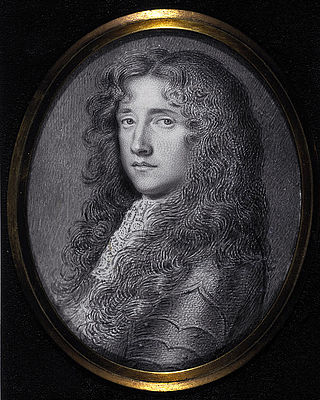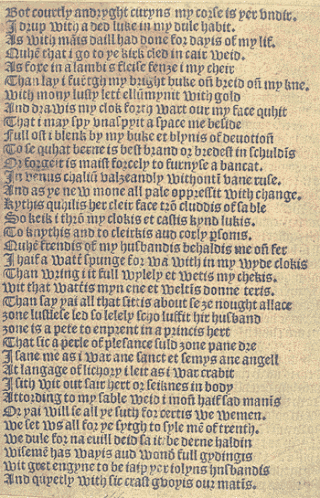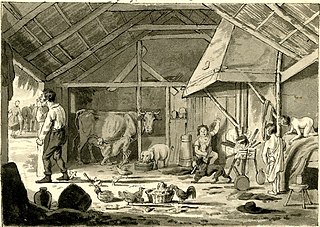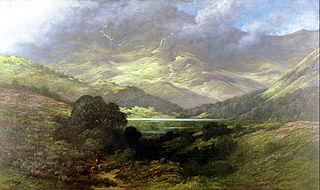
Bonnie Dundee is the title of a poem and a song written by Walter Scott in 1825 in honour of John Graham, 7th Laird of Claverhouse, who was created 1st Viscount Dundee in November 1688, then in 1689 led a Jacobite rising in which he died, becoming a Jacobite hero.

"Sir Patrick Spens" is one of the most popular of the Child Ballads, and is of Scottish origin. It is a maritime ballad about a disaster at sea.

"The Three Ravens" is an English folk ballad, printed in the songbook Melismata compiled by Thomas Ravenscroft and published in 1611, but the song is possibly older than that. Newer versions were recorded up through the 19th century. Francis James Child recorded several versions in his Child Ballads.
Patrick Ruthven, 3rd Lord Ruthven played an important part in the political intrigues of 16th century Scotland. He succeeded to the lordship in December 1552. The Ruthven lordship encompassed the offices of Provost and Constable of Perth, and Sheriff of Strathearn.

A Satire of the Three Estates, is a satirical morality play in Middle Scots, written by makar Sir David Lyndsay. The complete play was first performed outside in the playing field at Cupar, Fife in June 1552 during the Midsummer holiday, where the action took place under Castle Hill. It was subsequently performed in Edinburgh, also outdoors, in 1554. The full text was first printed in 1602 and extracts were copied into the Bannatyne Manuscript. The Satire is an attack on the Three Estates represented in the Parliament of Scotland – the clergy, lords and burgh representatives, symbolised by the characters Spiritualitie, Temporalitie and Merchant. The clergy come in for the strongest criticism. The work portrays the social tensions present at this pivotal moment in Scottish history.

"The Bonnie Banks o' Loch Lomond", or "Loch Lomond" for short, is a Scottish song. The song prominently features Loch Lomond, the largest Scottish loch. In Scots, "bonnie" means "fair" or "beautiful".

"The Taill of the Uponlandis Mous and the Burges Mous", also known as "The Twa Mice," is a Middle Scots adaptation of Aesop's Fable The Town Mouse and the Country Mouse by the Scottish poet Robert Henryson. Written around the 1480s, it is the second poem in Henryson's collection called The Morall Fabillis of Esope the Phrygian.

"The Taill of the Cok and the Jasp" is a Middle Scots version of Aesop's Fable The Cock and the Jewel by the 15th-century Scottish poet Robert Henryson. It is the first in Henryson's collection known as the Morall Fabillis of Esope the Phrygian. The Cok and the Jasp is framed by a prologue and a moralitas, and as the first poem in the collection it operates on a number of levels, and in all its parts, to introduce the larger cycle.

The Tua Mariit Wemen and the Wedo or The Tretis Of The Twa Mariit Wemen and the Wedo is a narrative poem in Scots by the makar William Dunbar.
Idyll VI, otherwise known as Bucolic poem 6, was written by Theocritus in dactylic hexameter. The exact date of its composition is unknown. It references characters that have appeared in other works of literature such as Homer's Odyssey, Ovid's Metamorphoses, and Theocritus' Idyll XI.

Ane Ballat of the Fenyeit Frier of Tungland, How He Fell in the Myre Fleand to Turkiland is a comic, satirical poem in Scots by William Dunbar composed in the early sixteenth century. The title may be rendered in modern English as A Ballad of The False Friar of Tongland, How He Fell in the Mire Flying to Turkey.

Meditatioun In Wyntir is a contemplative poem in Scots by William Dunbar.

The Dregy Of Dunbar also known as Dumbaris Dirige to the King is a humorous poem in Scots and Latin composed by William Dunbar. at an unknown date.

Remonstrance to the King is a Scots poem of William Dunbar composed in the early sixteenth century. The Remonstrance is one of Dunbar's many appeals to his patron James IV of Scotland asking for personal advancement. In this particular case, the unseemly personal pleading is combined with more dignified subject matter; lavish praise and pointed criticism of the King's court is delivered in an open manner.

"The Wife of Auchtermuchty" is a Scots poem of the fifteenth or sixteenth centuries.
"Quhy Sowld Nocht Allane Honorit Be" is an anonymous allegorical poem of the fifteenth or sixteenth century written in Scots.

The Thrissil and the Rois is a Scots poem composed by William Dunbar to mark the wedding, in August 1503, of King James IV of Scotland to Princess Margaret Tudor of England.

How the First Helandman of God Was Maid is an anonymous comic poem in Scots preserved in the Bannatyne Manuscript of the sixteenth century.

Patrick McGregor, better known as Gilderoy, was a Scottish outlaw and mass murderer who engaged in cattle raiding, blackmail and extortion in the regions of Strathspey, Braemar, Cromarty and other areas near Aberdeen during the Stuart period. After being caught by the Scottish authorities, he was executed in Edinburgh in 1636. McGregor has become a figure in Scottish folklore, including ballads, songs and idioms. His nickname has been alternatively rendered as Gilroy, Gilder Roy and Gilleroy.
Ane Dance in the Quenis Chalmer or A dance in the Queen's chamber is a humorous or satiric Scots poem by William Dunbar.

















